
Easily Saturday’s early morning Mass is the highpoint of my visit to the Syrian Orthodox Patriarchate in Sayyidnaya, Syria. The Syrians, unlike the Armenians, have weekday celebrations of the Divine Liturgy in addition to the Sunday celebration. The monks were very kind to invite me to take photographs from within the sanctuary and a pair of slippers were waiting for me at the curtained side entrance — street shoes are not allowed within the sanctuary itself . The Syrian liturgy is awe-inspiring, to say the least, and it is truly a privilege to stand on this holy ground to watch and pray (and take pictures as discretely as possible).

On my return to Antelias, I am also given the opportunity to take photographs during the Badarak (the Armenian Divine Liturgy). Fr. Krikor is the celebrant, and my presence; behind the closed curtain to take pictures has been planned between us for weeks. While this post is mainly concerned with the Syrian liturgy, these two recent sets of; photographs make comparison possible.
 Pictured here, above and to the left, we see the celebrants — the
Syrian Fr. Matta and the Armenian Fr. Krikor — preparing the elements for the
Eucharist before the beginning of the liturgy. The celebrant first chooses the
bread that will be offered. Carefully selecting the most perfect host from among
a selection of breads available, he looks for the spotless lamb of the priestly
sacrifice. As you can see, the Syrian priest does this before putting on the
liturgical vestments, while the Armenian robes first and then prepares the
elements.
Pictured here, above and to the left, we see the celebrants — the
Syrian Fr. Matta and the Armenian Fr. Krikor — preparing the elements for the
Eucharist before the beginning of the liturgy. The celebrant first chooses the
bread that will be offered. Carefully selecting the most perfect host from among
a selection of breads available, he looks for the spotless lamb of the priestly
sacrifice. As you can see, the Syrian priest does this before putting on the
liturgical vestments, while the Armenian robes first and then prepares the
elements.
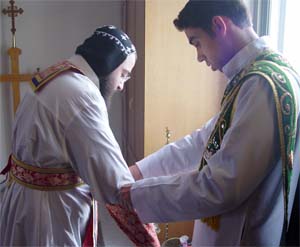 Once finished with the preparations, Fr. Matta puts on his priestly
vestments. The robes worn are nearly identical to the Armenians except that the
Armenian priest wears a crown, representing the Reign of Christ, and a high
collar, representing the lamb born by the Good Shepherd. Otherwise, the white
alb, priestly breast plate, sleeves and girdle, and the cope (a kind of cape)
are virtually the same.
Once finished with the preparations, Fr. Matta puts on his priestly
vestments. The robes worn are nearly identical to the Armenians except that the
Armenian priest wears a crown, representing the Reign of Christ, and a high
collar, representing the lamb born by the Good Shepherd. Otherwise, the white
alb, priestly breast plate, sleeves and girdle, and the cope (a kind of cape)
are virtually the same.
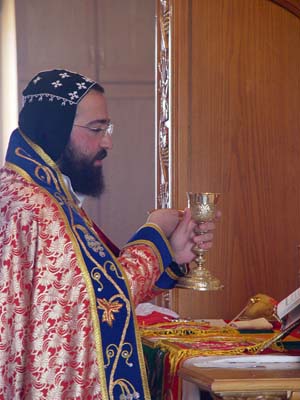 Inspired by the Book of Leviticus, Fr. Matta then presents the elements
as the offerings for the priestly sacrifice, crossing his wrists to do so and
reading the names of people listed on a piece of paper on the altar for whom the
sacrifice is particularly offered. These are the names of the sick and of the
recently departed (or those whose memorials are kept today.) The list is read
again later on in the liturgy, and one is impressed with the seriousness with
which the liturgy treats the ministry of intercession.
Inspired by the Book of Leviticus, Fr. Matta then presents the elements
as the offerings for the priestly sacrifice, crossing his wrists to do so and
reading the names of people listed on a piece of paper on the altar for whom the
sacrifice is particularly offered. These are the names of the sick and of the
recently departed (or those whose memorials are kept today.) The list is read
again later on in the liturgy, and one is impressed with the seriousness with
which the liturgy treats the ministry of intercession.
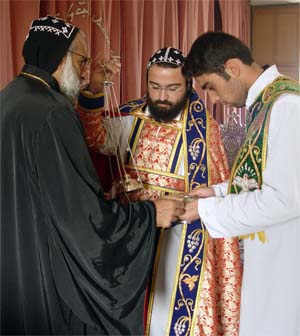
Assisting at the Syrian Mass on Saturday morning is His Grace, Bishop Mor
Athanasius Geevarghese, the
Patriarchal
Secretary for the Indian branch of
the Syrian Orthodox Church based in Kerula. The Syrian bishop has a bit more to
do during the liturgy than is the case among the Armenians, officially
presiding, as it were, particularly at moments like the blessing of the incense
pictured here. Both the Armenians and the Syrians put the bishop at the centre
of the action during the Kiss of Peace. I learn that Patriarch Zakka presides in
this way and is always the preacher at the Sunday Liturgy when he is in
residence at the Patriarchate.
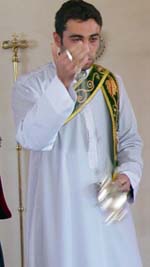 The
Syrian thurible (the incense burner) has a silver band at the end of its chain
that loops around the fore and middle fingers so that the deacon’s hand is open
as he swings the thurible. This he does with a back and forward movement shaking
his open palm so that the bells along the thurible’s chain make a distinctive
jingling sound as the thurible swings through the air.
Click here for a sound bite from
the liturgy taken at the beginning of the Gospel reading. In addition to the
jingling of the thurible, note the singing of the “alleluias” — in the western
church the word “alleluia” is; retired for the period of Lent, neither the
Syrians nor the Armenians seem to share this custom with the west.
The
Syrian thurible (the incense burner) has a silver band at the end of its chain
that loops around the fore and middle fingers so that the deacon’s hand is open
as he swings the thurible. This he does with a back and forward movement shaking
his open palm so that the bells along the thurible’s chain make a distinctive
jingling sound as the thurible swings through the air.
Click here for a sound bite from
the liturgy taken at the beginning of the Gospel reading. In addition to the
jingling of the thurible, note the singing of the “alleluias” — in the western
church the word “alleluia” is; retired for the period of Lent, neither the
Syrians nor the Armenians seem to share this custom with the west.
;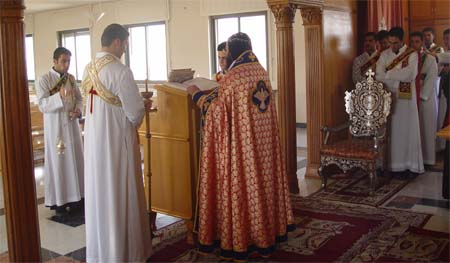
Here again there are some noticeable similarities and differences between the
way the Gospel is read in the Syrian and Armenian liturgies.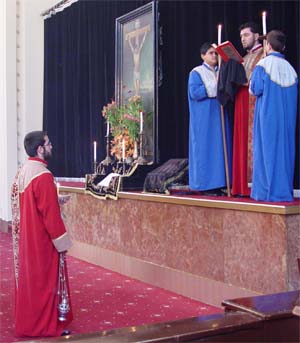 Common to both, the
acolytes (the “light bearers”) stand to either side of the Gospel book, and the
deacon with his thurible faces the reading. In the Syrian tradition it is the
priest who reads the Gospel from its own central lectern, while for the
Armenians it is always the deacon who reads the Gospel, standing in front and
south (or right) of the altar; — whether or not the curtain is drawn. Note that
the Armenian deacon holds the Gospel book in his hands with a piece of fine
fabric;– it is considered improper to touch the Gospel book with bare hands. No
lectern is available for the Gospel reading in the Armenian sanctuary.
Common to both, the
acolytes (the “light bearers”) stand to either side of the Gospel book, and the
deacon with his thurible faces the reading. In the Syrian tradition it is the
priest who reads the Gospel from its own central lectern, while for the
Armenians it is always the deacon who reads the Gospel, standing in front and
south (or right) of the altar; — whether or not the curtain is drawn. Note that
the Armenian deacon holds the Gospel book in his hands with a piece of fine
fabric;– it is considered improper to touch the Gospel book with bare hands. No
lectern is available for the Gospel reading in the Armenian sanctuary.
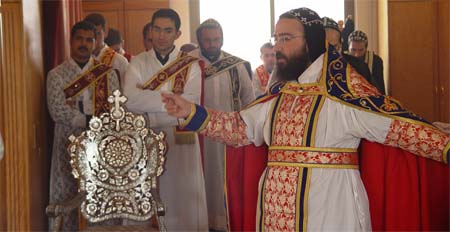
As pictured here, reminiscent of some of the most ancient illustrations of
the Christian liturgy, the choir of deacons in the Syrian tradition
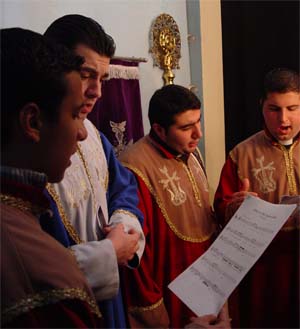 stands to the
north of the altar. In the Armenian tradition, a smaller group of deacons is
deployed; — the gallery choir does much of the singing. There are parts of the
Armenian liturgy reserved for the deacons to sing, and they usual stand on the
south side of the altar to do so, but will also move around (to the front and
north) as different moments in the liturgy require.
stands to the
north of the altar. In the Armenian tradition, a smaller group of deacons is
deployed; — the gallery choir does much of the singing. There are parts of the
Armenian liturgy reserved for the deacons to sing, and they usual stand on the
south side of the altar to do so, but will also move around (to the front and
north) as different moments in the liturgy require.
During the Synaxis (the first part of the liturgy with a focus on the readings from scripture), the elements prepared for; the Anaphora (the second part of the liturgy) are kept on the altar in the Syrian tradition, covered by a white embroidered veil.
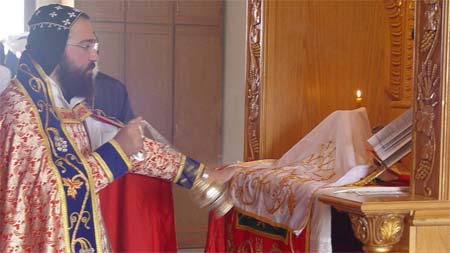
In the Armenian tradition, the elements are reserved in a niche in the north
wall of the sanctuary. In the picture below, Bikfaya junior seminarians Zorab
and Samuel;
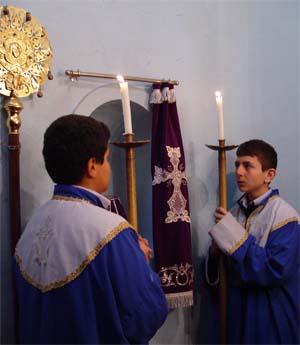 stand ready for the “Great Entrance” when the Armenian deacon carries
the elements in solemn procession around the altar (clockwise from the niche to
the front of the altar) to the priest waiting to receive them there.
Click here to see a film clip of the
procession in Armenian tradition.
stand ready for the “Great Entrance” when the Armenian deacon carries
the elements in solemn procession around the altar (clockwise from the niche to
the front of the altar) to the priest waiting to receive them there.
Click here to see a film clip of the
procession in Armenian tradition.
The elements are treated with great respect in both the Syrian and Armenian traditions, indeed this is so throughout the Orthodox world. There is a link here — or so I gather — between the elements of bread and wine about to be consecrated and the human creature who one day, through the Incarnation, becomes the very temple the Only Begotten Son of God. The procession of the elements, even using them to bless the congregation in the Armenian tradition, along with the solemnity that the Syrians reserve in handling them, speak of humanity’s sacred potential and of; the divine purpose for us all.
From the outset, I have been most impressed with the clearly visible
connection that is made, in the organisation of the Syrian sanctuary, between
the Gospel and the Divine Liturgy. The first photo in this post (above)
shows the normal, day-to-day configuration of the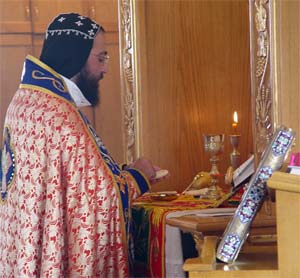 sanctuary where the
Gospel book rests on its own lectern directly in front of the altar where the
sacred vessels, always present, await the Divine Liturgy. The Syrian custom is
to have only an icon of Jesus or of the Trinity painted on the reredos of the
altar. Thus there is always this visible connection made in the organization of
the Syrian sanctuary: Jesus (or Godhead) - Altar - Gospel. I suspect this is
also the reason it is the priest and not the deacon who proclaims the Gospel —
putting this act on a par, liturgically, with the Eucharistic Prayer. To further
affirm the connection of Gospel and Eucharist, at the beginning of the Anaphora
(the Eucharistic Prayer) the Syrians move the Gospel lectern and its ornate
Gospel book so that it stands directly beside the altar lest we are tempted to
forget the Gospel injunction, “Do this in memory of Me.”
sanctuary where the
Gospel book rests on its own lectern directly in front of the altar where the
sacred vessels, always present, await the Divine Liturgy. The Syrian custom is
to have only an icon of Jesus or of the Trinity painted on the reredos of the
altar. Thus there is always this visible connection made in the organization of
the Syrian sanctuary: Jesus (or Godhead) - Altar - Gospel. I suspect this is
also the reason it is the priest and not the deacon who proclaims the Gospel —
putting this act on a par, liturgically, with the Eucharistic Prayer. To further
affirm the connection of Gospel and Eucharist, at the beginning of the Anaphora
(the Eucharistic Prayer) the Syrians move the Gospel lectern and its ornate
Gospel book so that it stands directly beside the altar lest we are tempted to
forget the Gospel injunction, “Do this in memory of Me.”
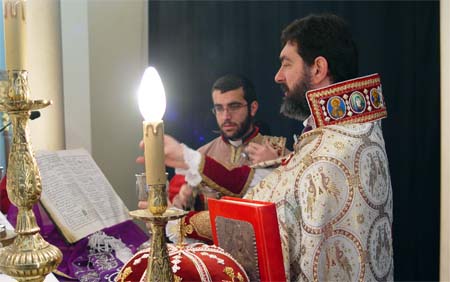
The Epiclesis, the calling or invocation of the Holy Spirit is as important to the Orthodox as the words of institution or consecration themselves. In the Armenian tradition, the choir sings a hymn calling upon the Holy Spirit, while the priest turns toward the deacon, calling upon the Holy Spirit and blessing first the bread and then the wine while the deacon reverences the elements with incense.
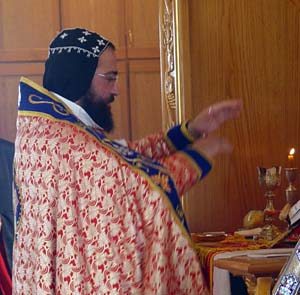 The
Syrians mark this very sacred moment in a wonderful way. The priests waves his
hands, palms down, in crossing circles, repeatedly moving one hand up, over the
other and sweeping down. This is in contrast to the single great sweep of hands
used for the Epiclesis in the western tradition: palms out, from the level of
the ears, up over the head and down; to rest above the consecrated elements.
The
Syrians mark this very sacred moment in a wonderful way. The priests waves his
hands, palms down, in crossing circles, repeatedly moving one hand up, over the
other and sweeping down. This is in contrast to the single great sweep of hands
used for the Epiclesis in the western tradition: palms out, from the level of
the ears, up over the head and down; to rest above the consecrated elements.
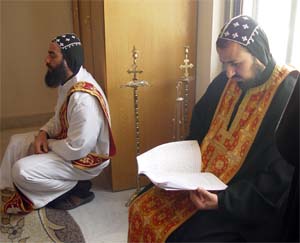 The
Epiclesis completed, the congregation and assisting ministers have a few moments
to sit and reflect. Le phre Roger, picture right, takes time to considers the
English translation of the Syriac (Aramean) text of the liturgy which Fr. Matta
has brought for my use and which le phre Roger kindly holds for me to read
throughout the liturgy — my hands occupied with the camera.
The
Epiclesis completed, the congregation and assisting ministers have a few moments
to sit and reflect. Le phre Roger, picture right, takes time to considers the
English translation of the Syriac (Aramean) text of the liturgy which Fr. Matta
has brought for my use and which le phre Roger kindly holds for me to read
throughout the liturgy — my hands occupied with the camera.
In the Syrian tradition, once the Anaphora is complete, the priest removes the cope or outer vestment and prepares for the administration of the sacrament.
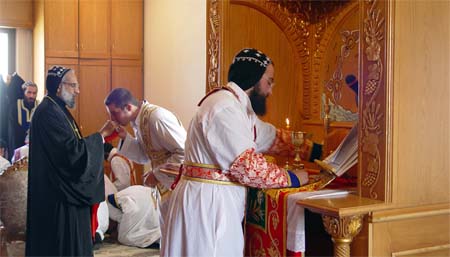
While he does this the congregation begins to prepare their hearts to receive
Holy Communion. Here, the deacons come first and kiss the bishop’s hand cross
and then they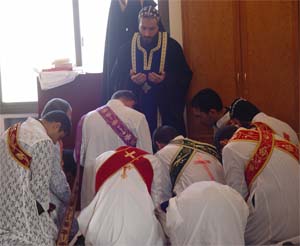 kneel to make a general confession at the feet of the priest appointed
to give the absolution. The Syrian priest in pronouncing absolution makes a
gesture moving his hands, palms up, to and from his chest that says, “I am also
a sinner, pray for me that I too may be forgiven my sins.”
kneel to make a general confession at the feet of the priest appointed
to give the absolution. The Syrian priest in pronouncing absolution makes a
gesture moving his hands, palms up, to and from his chest that says, “I am also
a sinner, pray for me that I too may be forgiven my sins.”
Proper preparation for communion is extremely important in the Orthodox
traditions, a lengthy penitential ritual is
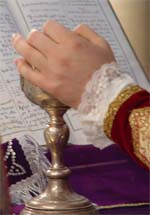 prominent in the
Armenian liturgy just before the administration of the sacrament (even so in
Lent, when only the priest receives communion). Some of the thinking here has to
do with a respect for the power of the sacrament and the belief that a
communicant approaching the altar without proper preparation can be spiritually
harmed. The believer must prepare with fasting and prayer, and time must also be
taken to make peace with God seeking the absolution of the Church.
prominent in the
Armenian liturgy just before the administration of the sacrament (even so in
Lent, when only the priest receives communion). Some of the thinking here has to
do with a respect for the power of the sacrament and the belief that a
communicant approaching the altar without proper preparation can be spiritually
harmed. The believer must prepare with fasting and prayer, and time must also be
taken to make peace with God seeking the absolution of the Church.
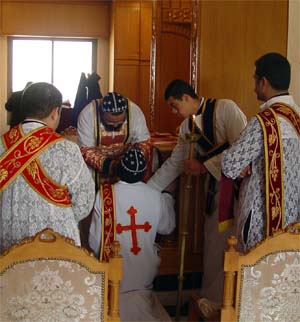 The
community comes forward to receive the sacrament in the usual Orthodox way,
kneeling or crouching low enough,; with the head tilted back, so that the priest
can drop a piece of broken communion bread dipped in the consecrated wine into
the open mouth of the communicant. In the Armenian tradition, because of the
liturgy is celebrated on a raised platform,
The
community comes forward to receive the sacrament in the usual Orthodox way,
kneeling or crouching low enough,; with the head tilted back, so that the priest
can drop a piece of broken communion bread dipped in the consecrated wine into
the open mouth of the communicant. In the Armenian tradition, because of the
liturgy is celebrated on a raised platform,
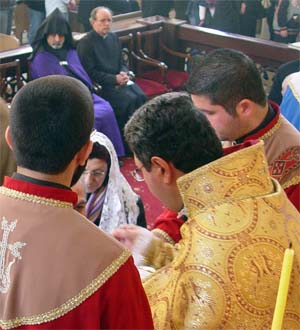 called the “bema”, the
priest kneels to administer the sacrament to the faithful. (Pictured here, Fr
Tatoul;; administering communion in a pre-Lenten liturgy in early
February.)
called the “bema”, the
priest kneels to administer the sacrament to the faithful. (Pictured here, Fr
Tatoul;; administering communion in a pre-Lenten liturgy in early
February.)
For those not receiving the sacrament, bread that has not been consecrated is
blessed by the presiding bishop and offered at the same time as Communion. This
practice is very useful when welcoming visitors from other traditions —
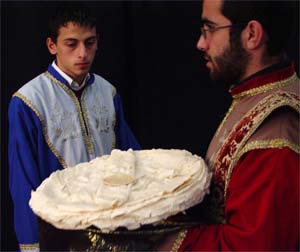 yours truly,
for instance .; It gives a sense of sharing in the common meal, if not in the
sacrament itself. The Armenians use a distinctive flat bread for this purpose,
while Syrians make use of the round breads not chosen during the preparation of
the elements, breaking them up into small portions.
yours truly,
for instance .; It gives a sense of sharing in the common meal, if not in the
sacrament itself. The Armenians use a distinctive flat bread for this purpose,
while Syrians make use of the round breads not chosen during the preparation of
the elements, breaking them up into small portions.
I have seen people at Armenian Catholicosate take some of the
un-consecrated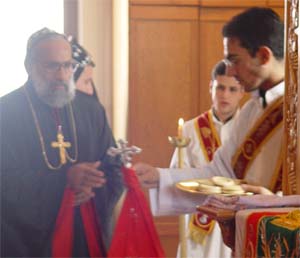 bread and wrap it in a handkerchief to take the bedridden or others
unable to attend the liturgy — so that they too can be included in the common
meal. Please note that the sick are able to receive the Sacrament from the
priest during a home visitation, much in the way this is done in the Anglican
and other Christian traditions, but the sharing of the un-consecrated bread
serves to include everyone in the liturgy in a less formal manner.;
bread and wrap it in a handkerchief to take the bedridden or others
unable to attend the liturgy — so that they too can be included in the common
meal. Please note that the sick are able to receive the Sacrament from the
priest during a home visitation, much in the way this is done in the Anglican
and other Christian traditions, but the sharing of the un-consecrated bread
serves to include everyone in the liturgy in a less formal manner.;
The administration of communion concludes the Divine Liturgy proper in both the Armenian and Syrian traditions. At the Syrian Patriarchate a lone deacon intones a beautiful meditative chant while the priest attends to the ablutions (the tidying up) — the congregation, however, leaves the chapel after receiving communion. The Syrian custom of fasting until noon is not kept on mornings when there is a celebration of the Divine Liturgy, and so most make their way to the dinning room for breakfast.
As I am
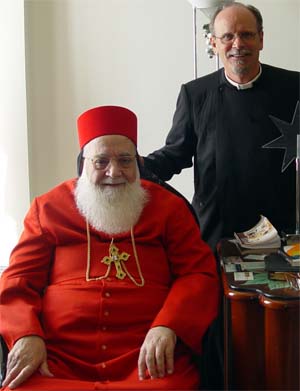 leaving the chapel, le phre Roger greets me invites me; into the
Patriarch’s offices for a final word; with his Holiness before my journey back
to the Catholicosate in Antelias. Patriarch Zakka seems a bit weary and I
remember that he rises in the middle of the night to work and pray, and has been
listening to the liturgy from his office beside the chapel before going to bed
for a few hours sleep.
leaving the chapel, le phre Roger greets me invites me; into the
Patriarch’s offices for a final word; with his Holiness before my journey back
to the Catholicosate in Antelias. Patriarch Zakka seems a bit weary and I
remember that he rises in the middle of the night to work and pray, and has been
listening to the liturgy from his office beside the chapel before going to bed
for a few hours sleep.
The venerable Patriarch and his community have been most gracious hosts, and even though I have only spent a couple of days with them, I come away blessed, with a powerful sense of spiritual enrichment, and I remain truly grateful.







